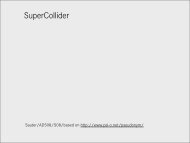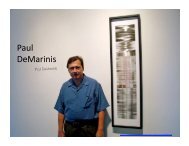the coming age of calm technology[1] - Daniel Sauter
the coming age of calm technology[1] - Daniel Sauter
the coming age of calm technology[1] - Daniel Sauter
- No tags were found...
Create successful ePaper yourself
Turn your PDF publications into a flip-book with our unique Google optimized e-Paper software.
Bits flowing through <strong>the</strong> wires <strong>of</strong> a computer network are invisible...http://www.ubiq.com/hypertext/weiser/acmfuture2endnote.htmIs that shirt I saw last week at Macy's still on <strong>the</strong> rack? Many researchers are working towards thisnew era - among <strong>the</strong>m our work at Xerox PARC, MIT's AI-oriented "Things That Think"program[7], <strong>the</strong> many mobile and wearable computing programs[8] (many funded by ARPA), and<strong>the</strong> many companies integrating computation into everyday objects, including Mattel and Disney.What qualifies <strong>the</strong>se as fundamental trends? First, <strong>the</strong>y are about basic human relationships, and soare trends about what matters to us, what we cannot avoid. Second, <strong>the</strong>y have <strong>the</strong> property <strong>of</strong>building upon one ano<strong>the</strong>r. It is apparent that <strong>the</strong> mainframe relationship will never die completelyaway, nor <strong>the</strong> personal computing relationship. Each is used as a ground for <strong>the</strong> next trend,confirming its importance in its own mode <strong>of</strong> decline. Third, <strong>the</strong>y are each bountiful sources <strong>of</strong>innovation, and have required reopening old assumptions, and re-appropriating old <strong>technology</strong> intonew contexts.It has been said many times that PC operating systems are about twenty years behind mainframeoperating systems - but this statement misunderstands what happens in technological revolutions.The radically new context <strong>of</strong> <strong>the</strong> PC - uncontrolled room, uncontrolled third party s<strong>of</strong>tware,uncontrolled power, third party hardware components, retail sales, low-cost requirements, frequentupgrades - meant that mainframe technologies required considerable adaptation. The era <strong>of</strong>ubiquitous computing is already starting to see old assumptions questioned top to bottom incomputer systems design. For instance, our work on ubiquitous computers required us to introducenew progress metrics such as MIPS/Watt and Bits/Sec/M 3 . (After over a decade <strong>of</strong> stagnation,MIPS/Watt has improved over a hundred-fold in <strong>the</strong> past three years.) Research from radios to userinterface, from hardware to <strong>the</strong>ory, are impacted by <strong>the</strong> changed context <strong>of</strong> ubiquity.[9]The most potentially interesting, challenging, and pr<strong>of</strong>ound change implied by <strong>the</strong> ubiquitouscomputing era is a focus on <strong>calm</strong>. If computers are everywhere <strong>the</strong>y better stay out <strong>of</strong> <strong>the</strong> way, andthat means designing <strong>the</strong>m so that <strong>the</strong> people being shared by <strong>the</strong> computers remain serene and incontrol. Calmness is a new challenge that UC brings to computing. When computers are used behindclosed doors by experts, <strong>calm</strong>ness is relevant to only a few. Computers for personal use havefocused on <strong>the</strong> excitement <strong>of</strong> interaction. But when computers are all around, so that we want tocompute while doing something else and have more time to be more fully human, we must radicallyrethink <strong>the</strong> goals, context and <strong>technology</strong> <strong>of</strong> <strong>the</strong> computer and all <strong>the</strong> o<strong>the</strong>r <strong>technology</strong> crowding intoour lives. Calmness is a fundamental challenge for all technological design <strong>of</strong> <strong>the</strong> next fifty years.The rest <strong>of</strong> this paper opens a dialogue about <strong>the</strong> design <strong>of</strong> <strong>calm</strong> <strong>technology</strong>.CALM TECHNOLOGYDesigns that en<strong>calm</strong> and inform meet two human needs not usually met toge<strong>the</strong>r. Information<strong>technology</strong> is more <strong>of</strong>ten <strong>the</strong> enemy <strong>of</strong> <strong>calm</strong>. P<strong>age</strong>rs, cellphones, news-services, <strong>the</strong>World-Wide-Web, email, TV, and radio bombard us frenetically. Can we really look to <strong>technology</strong>itself for a solution?But some <strong>technology</strong> does lead to true <strong>calm</strong> and comfort. There is no less <strong>technology</strong> involved in acomfortable pair <strong>of</strong> shoes, in a fine writing pen, or in delivering <strong>the</strong> New York Times on a Sundaymorning, than in a home PC. Why is one <strong>of</strong>ten enraging, <strong>the</strong> o<strong>the</strong>rs frequently en<strong>calm</strong>ing? Webelieve <strong>the</strong> difference is in how <strong>the</strong>y eng<strong>age</strong> our attention. Calm <strong>technology</strong> eng<strong>age</strong>s both <strong>the</strong> centerand <strong>the</strong> periphery <strong>of</strong> our attention, and in fact moves back and forth between <strong>the</strong> two.THE PERIPHERYWe use "periphery" to name what we are attuned to without attending to explicitly.[10] Ordinarilywhen driving our attention is centered on <strong>the</strong> road, <strong>the</strong> radio, our passenger, but not <strong>the</strong> noise <strong>of</strong> <strong>the</strong>engine. But an unusual noise is noticed immediately, showing that we were attuned to <strong>the</strong> noise in<strong>the</strong> periphery, and could come quickly to attend to it.3 <strong>of</strong> 7 3/3/08 12:25 PM


![the coming age of calm technology[1] - Daniel Sauter](https://img.yumpu.com/47923551/3/500x640/the-coming-age-of-calm-technology1-daniel-sauter.jpg)







